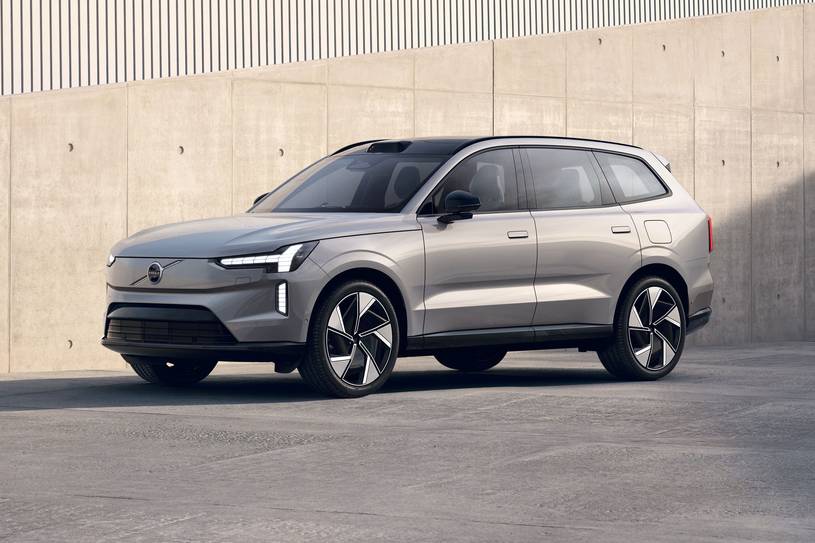2025 Volvo EX90
Price Range: $79,995 - $89,845
Helpful shopping links
2025 Volvo EX90 videos
Volvo EX90 vs. Kia EV9 vs. Volkswagen ID. Buzz: Which 3-Row EV Is Best?
Until recently, your options for 3-row electric vehicles were pretty limited. The segment has expanded rapidly, though, and there are more choices than ever before, including two of the most hyped vehicles of 2025: the Volvo EX90 and Volkswagen ID. Buzz. But how do these newcomers stack up against the Edmunds Top Rated Electric SUV, the Kia EV9? Edmunds' Brian Wong finds… out in this comparison test video.
PRICE CHECKER™
Check a dealer's price
Bring back a dealer's quote, and we'll tell you if it's a good price!
Check your price quote
Price:
$ -
Graph shown is a sample only
FAQ
Is the Volvo EX90 a good car?
The Edmunds experts tested the 2025 EX90 both on the road and at the track, giving it a 8.1 out of 10. And then there's safety and reliability. Edmunds has all the latest NHTSA and IIHS crash-test scores, plus industry-leading expert and consumer reviews to help you understand what it's like to own and maintain a Volvo EX90. Learn more
What's new in the 2025 Volvo EX90?
According to Edmunds’ car experts, here’s what’s new for the 2025 Volvo EX90:
- All-new three-row electric SUV
- Range of 300-plus miles
- Two trims, two power levels
- Kicks off the first EX90 generation for 2025
Is the Volvo EX90 reliable?
To determine whether the Volvo EX90 is reliable, read Edmunds' authentic consumer reviews, which come from real owners and reveal what it's like to live with the EX90. Look for specific complaints that keep popping up in the reviews, and be sure to compare the EX90's average consumer rating to that of competing vehicles. Learn more
Is the 2025 Volvo EX90 a good car?
There's a lot to consider if you're wondering whether the 2025 Volvo EX90 is a good car. Edmunds' expert testing team reviewed the 2025 EX90 and gave it a 8.1 out of 10. Safety scores, fuel economy, cargo capacity and feature availability should all be factors in determining whether the 2025 EX90 is a good car for you. Learn more
How much should I pay for a 2025 Volvo EX90?
The least-expensive 2025 Volvo EX90 is the 2025 Volvo EX90 Twin Motor Plus 4dr SUV AWD w/7 Seats (electric DD). Including destination charge, it arrives with a Manufacturer's Suggested Retail Price (MSRP) of about $79,995.
Other versions include:
- Twin Motor Plus 4dr SUV AWD w/7 Seats (electric DD) which starts at $79,995
- Twin Motor Plus 4dr SUV AWD w/6 Seats (electric DD) which starts at $80,495
- Twin Motor Ultra 4dr SUV AWD w/7 Seats (electric DD) which starts at $84,345
- Twin Motor Ultra 4dr SUV AWD w/6 Seats (electric DD) which starts at $84,845
- Twin Motor Performance Plus 4dr SUV AWD w/7 Seats (electric DD) which starts at $84,995
- Twin Motor Performance Plus 4dr SUV AWD w/6 Seats (electric DD) which starts at $85,495
- Twin Motor Performance Ultra 4dr SUV AWD w/7 Seats (electric DD) which starts at $89,345
- Twin Motor Performance Ultra 4dr SUV AWD w/6 Seats (electric DD) which starts at $89,845
What are the different models of Volvo EX90?
If you're interested in the Volvo EX90, the next question is, which EX90 model is right for you? EX90 variants include Twin Motor Plus 4dr SUV AWD w/7 Seats (electric DD), Twin Motor Plus 4dr SUV AWD w/6 Seats (electric DD), Twin Motor Ultra 4dr SUV AWD w/7 Seats (electric DD), and Twin Motor Ultra 4dr SUV AWD w/6 Seats (electric DD). For a full list of EX90 models, check out Edmunds’ Features & Specs page. Learn more













